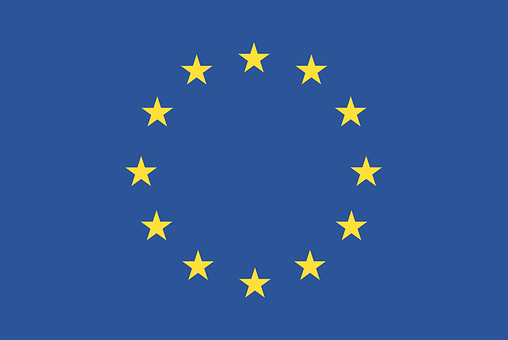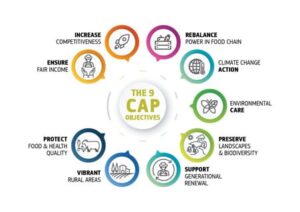With the expansion of cities and the disappearance of agricultural lands, I often wonder how rural the EU still is. Well, according to the EU Commission, it appears that around 85% of the EU’s territory is classified as rural (48% is farm land and 27% forest) and that it is home to around half its population (farming communities and other residents). And did you know that we have about 12 million full-time farmers in the continent, with an average farm size of about 15 hectares? (By way of comparison, the US has two million farmers and an average farm size of 180 hectares). Overall, agriculture and the agri-foods industry – which is heavily dependent on the agricultural sector for its supplies – account for 6% of the EU’s GDP, comprise 15 million businesses and provide 46 million jobs.
In terms of types of farming, there is a wide variety in the EU, including conventional, intensive and organic farming. The arrival of the new member countries of central and eastern Europe further increased that diversity. The most typical type of farms are family farms, which are often passed on from one generation to the next.
A common agricultural policy
The EU has 508 million inhabitants which makes it the world’s third largest population after China and India. So, it made sense to have a joint policy on agriculture. This policy is laid down in the Common Agricultural Policy (CAP), which was introduced in 1962 and has undergone many changes since its inception. The CAP is aimed to enable European farmers to meet the needs of over 500 million Europeans. Its main objectives are to ensure a decent standard of living for farmers and to provide a stable and safe food supply at affordable prices for consumers.
Governance of the CAP
Before drawing up proposals, the European Commission cooperates with a number of stakeholders, mainly through its many advisory groups. The Council of agriculture ministers of the 27 EU countries, together with the European Parliament, decides on the Commission’s proposals. The day-to-day running of the CAP is the responsibility of the member countries. The budget is decided every year by the Council of the EU and the European Parliament. To keep long-term spending under control, they work within a multi-year ‘financial framework’.
Funding of the CAP
Money for the CAP comes from the EU’s general budget, and CAP spending on rural development is jointly financed by the EU and its member countries. The EU budget is in turn mainly financed out of its ‘own resources’: customs duties, levies, VAT and resources based on member countries’ gross national income.
Cost per citizen
According to the EU, the CAP costs each EU citizen around 30 eurocents a day. In 2011 it accounted for 43% of the EU’s annual budget, or €58 billion. Its share has been falling continuously since 1984, when it stood at 72%, while the successive enlargements of the EU since 1992 have resulted in a doubling of the number of farmers. The Commission states that CAP expenditures actually make up less than 1% of all public expenditures in all the EU’s member countries. Public expenditures on the farming sector in the EU has been pooled at European level, which is not the case for any other economic sector. By comparison, EU countries spend three times more on defence.
Allocation of the money
The CAP budget for 2014-20 for all 28-member countries totals €95 billion (current prices) and this money comes from the European Agricultural Fund for Rural Development (EAFRD).
The CAP’s budget is spent in three different ways:
- About 70% of the CAP budget goes to income support for farmersand assistance for complying with sustainable agricultural practices. Farmers receive direct payments, provided they live up to strict standards relating to food safety, environmental protection and animal health and welfare. [These payments are fully financed by the EU. Under the latest reform of 2013, 30% of direct payments are linked to European farmers’ compliance with sustainable agricultural practices which are beneficial to soil quality, biodiversity and the environment generally, such as crop diversification, the maintenance of permanent grassland or the preservation of ecological areas on farms.]
- A little less than 10% of the CAP budget goes to market-support measures: these come into play, for example, when adverse weather conditions destabilise markets.
- The remaining 20% of the CAP budget goes to rural development measureswhich are intended to help farmers modernise their farms and become more competitive, while protecting the environment, contributing to the diversification of farming and non-farming activities and the vitality of rural communities. These payments are partly financed by the member countries and normally extend over a number of years.
Modernization of European agriculture
To encourage modernisation, and to help farmers improve their farms, their processes and sell their produce and produce higher-quality foods using more sustainable, environmentally-friendly farming methods, there are many incentives in the CAP. It is offering measures to facilitate collective investment, help small farms to develop and encourage transfers of agronomic know-how between farmers through a European Innovation Partnership in the farming sector.
Achieving the aims of CAP
The effectiveness of the CAP is closely evaluated. Before making any legislative proposals, the Commission consults stakeholders and citizens, and conducts impact analyses. It also regularly commissions independent studies on the performance of the CAP’s various instruments and how they can be improved.
Young people wanting to become farmer
Given the difficulty of the work involved and the scale of investment required to set up a farm, there are unfortunately fewer and fewer farmers in Europe. At present 4.5 million farmers in Europe (30%) are over 65, and only 6% are under 35. So, to ensure the future of farming, it must be made more attractive, and young people need to be given help in entering the sector. To achieve these goals and encourage generation renewal in farming the CAP offers setting-up aid mechanisms. The 2013 reform introduced a new type of aid for young farmers: a bonus corresponding to 25% of the amount of direct payments payable to young farmers in their first five years of working in the sector.
Difference agriculture vs. other sectors
Agriculture is the only sector entirely funded from the EU budget, meaning that EU spending replaces national spending. Other areas, such as research, education, transport, defence, pensions and healthcare are either not included in the EU budget or take a much smaller share because they are paid for – fully or partially – out of national budgets and are implemented by the EU countries themselves. In return, the CAP guarantees the European public a dependable and plentiful supply of high-quality food, as well as a healthy environment and exceptional landscapes.
What about biofuels, and are these responsible for the increase in food prices?
Various studies available suggest that the production of biofuels in the EU does not play a significant role in raising food prices. Only 1% of the EU’s cereals go into the production of ethanol. Around 2/3 of our oilseed rape production goes into the production of biodiesel, but this accounts for only 2% of world demand. Nevertheless, we must invest in second and third generation biofuels.
Food safety
The EU has improved food safety significantly since the 1990s by introducing hygiene measures, rules on animal and plant health, and checks on pesticide residues and additives in food, to give but a few examples. Food regulations in Europe are among the most stringent in the world.
Guaranteeing food quality
There are a few ways in which the EU guarantees food quality for example through labelling, marketing and quality rules, such as the protection of geographical indications, mandatory nutritional information on labels, quality logos and animal welfare standards, etc.
But apart from hygiene rules which guarantee safe products, the EU has also developed the following:
- marketing standards that products sold in the EU are required to meet;
- optional quality terms to indicate the quality of the product on the label;
- European systems of quality to identify products with a specific quality;
- ‘Protected Designation of Origin’ (PDO) or ‘Protected Geographical Indication’ (PGI) for quality linked to geographical origin;
- ‘Traditional Speciality Guaranteed’ (TSG);
- a special EU logo for organic products meeting strict production requirements;
- guidelines to optimise the performance of food quality certification systems guaranteeing compliance with certain product characteristics or processes.
The need for a ‘common’ agricultural policy at EU level
Unlike most other sectors which are governed by national policies, agriculture is a sector which is supported almost exclusively at European level. Therefore, the EU Commission considers it important to have a public policy for a sector that is responsible for ensuring food safety and which plays a key role in the use of natural resources and the economic development of rural areas. All the EU countries share these objectives and agree that measures must be taken at European level to ensure fair conditions with a common set of objectives, principles and rules. A collective EU policy also makes for better use of budgetary resources than would the coexistence of national policies.
Previous CAP reforms
The most substantial reforms to the CAP began in 1992 and intensified in 2003, when the link between subsidies and production was cut. This means that, in order to receive subsidies, farmers no longer have to produce food for which there is no market. Instead, they are now free to produce what the market and consumers want, look for profitable new markets and exploit new niches. Farmers now receive income support, provided they look after their farmland and meet food-safety, environmental and animal welfare standards – failing which, their payments are reduced.
The next CAP reform
On 1 June 2018, the European Commission presented the legislative proposals on the future of food and farming. One of the main changes is that the Commission proposes that funding for the CAP is moderately reduced –by around 5% – to reflect the new reality of a Union at 27.
Based on nine objectives, the future CAP will continue to ensure access to high-quality food and strong support for the unique European farming model with an increased focus on the environment and climate, supporting the transition towards a more sustainable agricultural sector and the development of vibrant rural areas.
The future CAP plans to give priority to:
- supporting small and medium-sized family farms, as wells as encouraging young farmers to join the profession
- guaranteeing higher ambition on environmental and climate action, and supporting farmers who meet greater environmental and sustainability standards
- encouraging the development of vibrant rural societies and helping farmers meet public expectations on food quality and health
CAP 2020 reform proposals
To implement the future CAP, the European Commission proposes measures such as:
- reducing and then capping the direct payments to farmers at €60,000 per farm (taking into account labour)
- EU countries having to ensure a higher level of payment per hectare for small and medium-sized farms
- a minimum of 2% of direct support payments allocated to each EU country will be set aside for young farmers, that can include an increased “installation allowance” of up to €100,000
- EU countries having to ensure that only genuine farmers receive support
- new obligations for farmers: preserving carbon-rich soils through protection of wetlands or peatlands; an obligatory nutrient management tool to improve water quality, reduce ammonia and nitrous oxide levels; crop rotation instead of crop diversification
- eco-schemes set up by EU countries to support and/or incentivise farmers to observe agricultural practices beneficial for the climate and the environment, beyond their mandatory requirements
- encouraging new generations of farmers to join the profession, such as the mentoring of young farmers by more experienced ones, improving knowledge transfer from one generation to the next or developing succession plans
- encouraging EU countries to do more at national level, for example through more flexible rules on taxation and inheritance, to improve access to land for young farmers
- tougher requirements for farmers to meet expectations on food and health, such as linking financial support more closely to compliance with rules on reducing pesticide use, encouraging a reduction in the use of antibiotics, etc.
Knowledge and innovation
Greater use of knowledge and innovation is also high in the European Commission’s plans, expecting a dedicated budget of €10 billion from the EU’s research programme “Horizon 2020”, for research and innovation in food, agriculture, rural development and the bio-economy. The agricultural European innovation partnership (EIP-AGRI) will continue to pool funding sources from Horizon Europe and rural development to foster competitive and sustainable farming and forestry.
Europe’s agriculture through time
- 1957: The Treaty of Rome creates the European Economic Community (the precursor of today’s EU), between six western European countries.
- 1962: The common agricultural policy is born. The CAP is conceived as a common policy, with the objectives of providing affordable food for EU citizens and a fair standard of living for farmers.
- 1984: The CAP falls victim to its own success. Farms become so productive that they grow more food than needed. The surpluses are stored and lead to ‘food mountains’. Several measures are introduced to bring production levels closer to what the market needs.
- 1992: The CAP shifts from market support to producer support. Price support is scaled down and replaced with direct payments to farmers. They are encouraged to be more environmentally friendly. The reform coincides with the 1992 Rio Earth Summit, which launches the principle of sustainable development.
- 2003: The CAP provides income support. A new CAP reform cuts the link between subsidies and production. Farmers now receive an income support, on condition that they look after the farmland and fulfil food safety, environmental, animal health and welfare standards.
- 2013: The CAP is reformed to strengthen the competitiveness of the sector, promote sustainable farming and innovation, to support jobs and growth in rural areas and to move financial assistance towards the productive use of land.
###
Source: “The common agricultural policy (CAP) and agriculture in Europe – Frequently asked questions” – http://europa.eu/rapid/press-release_MEMO-13-631_en.htm – Accessed 13 June 2018
Source: Future of the common agricultural policy: https://ec.europa.eu/info/food-farming-fisheries/key-policies/common-agricultural-policy/future-cap_en#proposalAccessed 19 June 2018














